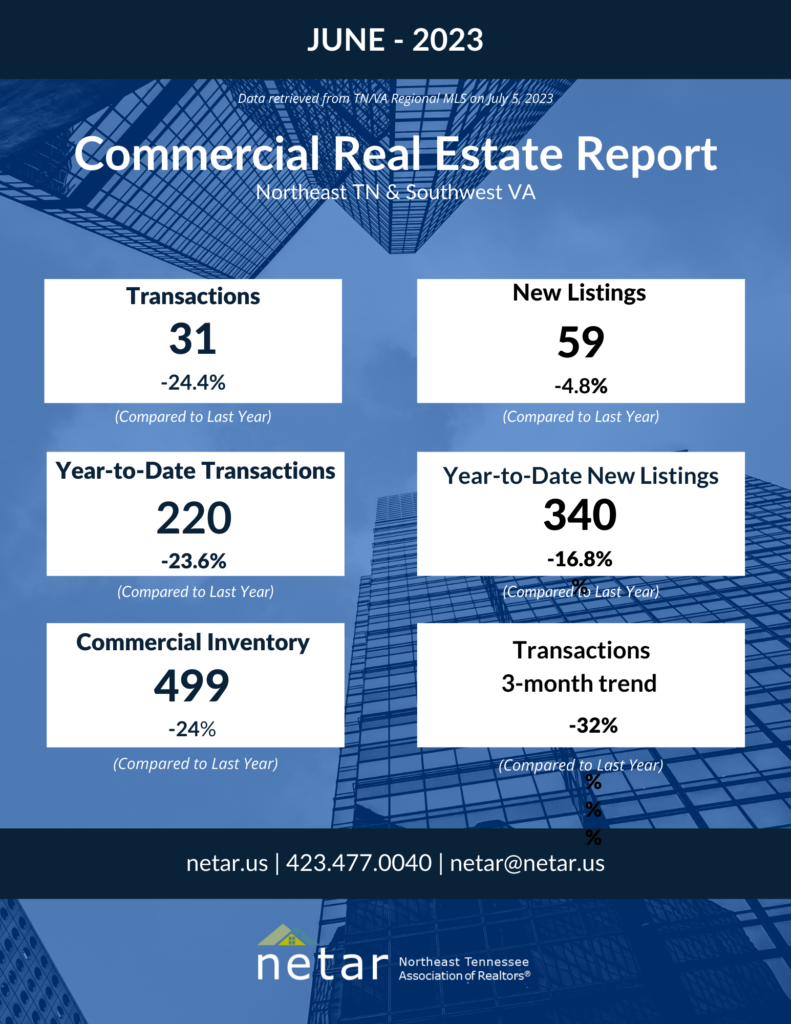Commercial real estate deals down, market resilient
Don Fenley
GRAY – Commercial real estate transitions in June and the first half of this year have been tepid while the overall market has remained resilient, according to the Northeast Tennessee Association of Realtors (NETAR).

“That’s typical during a period when there’s economic uncertainty,” said Jerry Petzoldt, chair of the NETAR’s Commercial Committee. “Investors and businesses are working through uncertain times to assess their positions and find new solutions and opportunities when economic conditions and the business cycle return to normal.”
This year’s stress tests covered 23 big banks. The Fed says those banks could withstand a 40% fall in commercial real estate prices and aggregate losses of more than half a trillion dollars without failing.
The local multi-family, retail and office sectors continue to perform well, but below last year’s levels.
MULTI-FAMILY
From a transactions standpoint, multi-family has outperformed the other sectors with 42 sales this year, down from 46 last year. According to a National Association of Realtors (NAR) insights analysis, multi-family performance are divided along metro lines.
Demand in the three-county Johnson City metro market has been stronger than it is nationwide. “As a result, rents rose faster, and the vacancy rate (5.9%) is lower than it was last year (6.1%).
Demand in the four-county Kingsport-Bristol metro area is weaker than it is nationwide, with a slower absorption rate. Despite weaker conditions, rents have risen faster than they did nationwide, and the vacancy rate is lower. The current local vacancy rate is 5.5% compared to 2.3% this time last year.
The latest report from the Tri-Cities Apartment Association cities a vacancy rate of 3.7%.
The Johnson City cap rate is 5.9%, down from 6.1% last year. In the Kingsport-Bristol metro area it’s 6%, down from 6.4% last year.
RETAIL
So far this year there have been 30 sales and leases. Last year there were 46. Much of the local activity has been in neighborhood retail.
Demand in the Johnson City metro area has been weaker than it has been nationwide, resulting in a slower absorption of retail space. Despite weaker conditions, rent prices have risen faster than they have nationwide, and the vacancy rate is lower.
NAR’s report shows a 2% vacancy rate in the Johnson City metro area, down from 2.5% last year.
Kingsport-Bristol demand is also weaker than it is nationwide, and the absorption rate is slower. Like Johnson City rent prices have risen faster than they have nationwide, and the vacancy rate is lower.
NAR’s analysis shows a 2% retail vacancy rate in Kingsport-Bristol, down from 3.2% last year.
The transaction sales price in the Johnson City metro area is $138 a square foot, up from $113 last year. In Kingsport-Bristol it’s $90 a square foot, down from $108 last year.
OFFICE
Officer transactions are down by half from last year. So far this year there have been 28 sales and leases. According to local commercial Realtors, investors are not the primary movers in this sector. That distinction goes to local businesses redirecting their workforce needs.
NAR’s insights analysis of the two local metro areas shows demand is stronger than the national level in Kingsport-Bristol and weaker in the Johnson City metro area.
Johnson City has a slower absorption of office space. Despite weak conditions, rents rose faster than they did nationwide, and the vacancy rate is lower in the area.
Kingsport-Bristol’s absorption rate is higher than it is nationwide, and the vacancy rate is lower than the national level. The current vacancy rate is 4.9%, down from 5.6% last year.
Office rent prices in the Johnson City metro have risen faster than they have nationwide despite lower demand. The vacancy rate in the three-county metro area is 2.5%, up from 2.1% last year.
The cap rate in Kingsport-Bristol is 8.7%, down from 8.8% last year. Johnson City’s cap rate is 9.2%, unchanged from last year.
INDUSTRIAL
The last sector in the NAR analysis is industrial. So far this year the region has logged 11 transactions, down 50% from last year. The strongest headwind for the industrial sector is lack of local inventory.
Industrial demand in both Tri-Cities metro areas is weaker than it is nationwide. But like the other sectors, rent prices have risen faster than they have on the national level and the vacancy rate is slow.
The Kingsport-Bristol vacancy rate is 3.8%, up from 2.3% last year. In Johnson city is 1.9%, up from 1.1% last year.
NETAR is the voice for real estate in Northeast Tennessee. It is the largest trade association in the Northeast Tennessee, Southwest Virginia region, representing over 1,800+ members and 100+ business partners involved in all aspects of the residential and commercial real estate industries. Weekly market reports and information for both consumers and members are available on the NETAR website at https://netar.us
